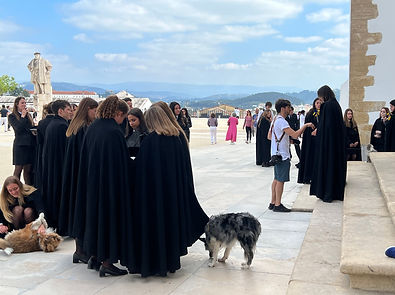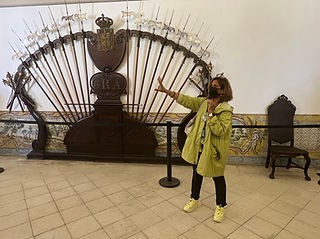
Coimbra
More of Day 7: May 1
Today was Mother's Day in Portugal. It was also Claúdia's mother's birthday. When we were on the bus traveling from Fátima to Coimbra. Claúdia rang her up on the phone, set to speaker mode. I'd like to think that Rosa got a chuckle out of having a bus-full of her daughter's newest American friends robustly singing Happy Birthday to her!
In Coimbra we had a two night stay at the Coimbra Riversuites, a 26-room hotel located at the end of a bridge leading over the river to the city’s historic old town area. The cluster of red-roofed buildings pictured above was our view from the bridge’s sidewalks. For many years, the Portuguese royal family lived in the large buildings at the top of that hill, Alcáçova Palace. Today the prestigious University of Coimbra occupies those buildings, with students roaming the vast hilltop courtyard where nobles once strutted. Now that's what I'd call "higher education!"
The University of Coimbra is Portugal’s oldest university but hasn’t always been located in this city. It was founded in 1290 in Lisbon, then moved to Coimbra, and for two and a half centuries it continued to move back and forth between the two cities. It finally settled permanently in Coimbra in 1537.
Having a major public university in Coimbra gives the whole city a youthful vibe. This afternoon we were getting an up-close look at all that fresh-faced energy because our local guide, Cristine, was giving us a tour of the university campus and buildings.
We really couldn’t have been here at a more perfect time. Cristine told us that in one more week, the students would be done with final exams and taking part in the “burning of the ribbons.” Each of the university's eight schools (Letters, Law, Medicine, Science & Technology, Pharmacy, Economics, Psychology & Educational Sciences and Sports Science & Physical Education) has its own ribbon color. When the ribbons are ceremoniously burned at the start of graduation week, it kicks off eight straight days when the students sleep during the day so that they can be up all through the night, partying and celebrating. Being ahead of that by a week, we wouldn’t have to worry about how sound-proofed our hotel might be, but we did get to experience the students in a festive good mood, with the end of the academic year so close at hand.




I loved watching the smiling students as they gathered in the old palace courtyard to pose for group photos with their classmates and individual photos with their friends. I thought that they had donned their graduation gowns for this end-of-the-year photo op but learned that the wool capes are the academic robes awarded to them at the end of their freshman initiation rituals. The wearing of robes is a time-honored tradition at this school. The students wear them for special academic occasions, of course, but on any given regular day of the school year, you’ll see students who’ve opted to wear their robes to class. Claúdia told me that in Portugal there is so much pride attached to the wearing of academic robes that when you are invited to a wedding, you show honor to the bride and groom by getting out your robes and wearing them to the wedding. She wore hers for her sister’s wedding.






As Cristine took us into the rooms of the university, she described their original royal purpose and their use today.
Weapons are still on display in what was the palace's Hall of Arms. Today they belong to the Royal Academic Guard and are used in formal ceremonies, such as the investiture of a new rector.
The Great Hall of Acts is a large room with beautiful painted wooden ceiling panels, the walls lined with portraits of kings. It was once the throne room of the palace. Now it is where PhD candidates defend their theses.
The Private Examination Room started as the royal chamber, where the king slept. In the 16th, 17th and 18th Centuries, it is where doctoral candidates underwent oral exams in secret, called into this room one by one in the middle of the night. Today it is still used for examinations but they're no longer secret nighttime events. The ceiling is painted with the royal coat of arms and the crests of the eight schools within the university. The walls contain portraits of university rectors.
The palace chapel was dedicated to St. Michael and now is the chapel of the university. The tiled walls and painted ceiling are beautiful, but the jaw-dropping feature of the chapel is the Baroque organ. It has 2,000 pipes, some of which fan straight into the room.
On our tour of the campus we also saw the Monumental Staircase. Cristine told us that on the first day of the academic year, the university's professors arrive on campus with a traditional walk up these stairs. During praxe, or freshman initiation rituals (what we might term hazing), merciless upperclassmen require the new students to make many treks up and down while counting the 125 steps.











Cristine took us out onto a long Palace balcony so that we could enjoy the view shown below, but even more delightful than this panoramic sight was what we heard. There was a roving band of male students singing Fado music in the streets below us, so beautifully harmonic that we at first thought we were hearing recorded music. Although in Lisbon, where Fado was born, it is sung by both men and women, here in Coimbra, only men sing Fado. One of the enduring traditions at this school is for groups of male student musicians to roam the streets singing Fado. This includes the serenading of women with love songs. The lyrics heard at the end of the academic year are usually the students’ nostalgic farewell to student life, to their beloved university, and to all the women they loved during their time here.


Wow!!
The building with arched windows pictured at left is the university's library. The first floor is a student jail, from when the university had its own police force. It is the only remaining medieval prison in Portugal. The middle floor is a regular library, pictured in the photo at lower left. The 3rd floor is called Noble Floor and requires a timed entry ticket. It is the university's crowning glory, one of the most beautiful libraries in the world.
Noble Floor consists of three rooms of gilded bookshelves that hold a rare collection of over 200,000 ancient books and a collection of illuminated manuscripts. The rooms are connected by massive arched doorways and have beautiful tromp l'oeil ceilings, gorgeous carved wood balconies and posts, and stunningly opulent chandeliers.
I love all libraries, but I don't think I'll ever see another one as amazing as this! A wow moment for me!
A somewhat creepy but very interesting fact about the library is that it is home to a colony of small bats. They've been welcome guests for two centuries. The bats come out at night and eat the flies, gnats and other bugs that could ruin the valuable books. Each bat can eat 500 insects a night.
Photos are not permitted on Noble Floor but after our tour, Claúdia used our group's private Facebook page to share a photo of hers, taken years ago. She was allowed to take the photo and gave me permission to use it:


We had a group dinner this evening at a very nice little restaurant called Sala Para Groupos. Our entrée choices were fish or roast suckling pig. While the food and atmosphere were both wonderful, what I'll remember most about this dinner was our friendly, animated waiter, who engaged us in conversation while making sure we never saw the bottom of our wine glasses. He shared with our table that this was his first ever restaurant job. It was recently offered to him by a friend and he was happy to accept, thrilled to be working again for the first time since the Covid pandemic began. He'd previously been employed as a sales representative for one of the world's largest pharmaceutical companies. He didn't know when, if ever, he might be re-employed in that career. He wasn't seeking pity. These are the conversations people around the world have with each other now that we've all been in a pandemic together. Those of us sitting around that table knew how very privileged we were to be traveling. It will never be taken for granted again.


